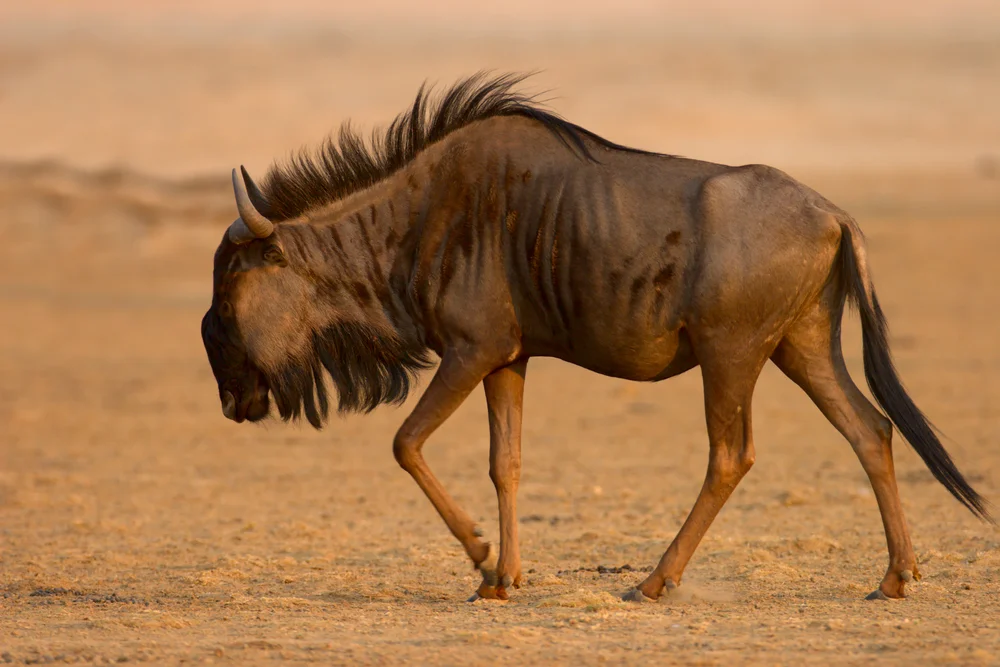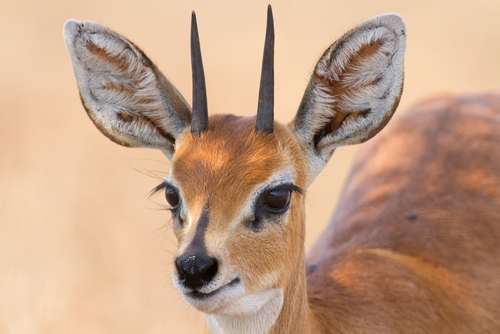Sable Rock Game
Blue Wildebeest
Habitat: Open Woodland, scrub and grassland.
Weight: Male 240-250kg, Female 180-215kg
Description of horn: Both sexes have horns growing sideways from bosses on the forehead, and then hooking upwards and inwards.
Average horn size: 24 inches (RW 28.5; SCI 70)
Interesting fact: Often referred to as the “poor man’s buffalo”, so a well-placed shot in the shoulder is necessary.
Black Wildebeest
Habitat: Open Karoo and grassland
Weight: Male 160kg, Female 130kg
Description of horns: Grow downward and forward from bosses on the forehead and they hook sharply upwards into a distinctive pitchfork shape.
Average horn size: 16 – 20 inches (RW 22 7/8; SCI 72)
Interesting fact: Living on open plains, black wildebeest are not hard to locate, but approaching them and determining sex and horn size may be difficult, especially in areas where they are regularly hunted. Often there is little cover and long shots may be required.
Blesbok
Habitat: Grassland
Weight: Male 70kg, Female 61kg
Horns: Both sexes have horns, strongly ridged except at the tips, straw coloured on the ridges. Male’s horns are thicker than females.
Average horn size: 14 inches (RW 16.5; SCI 40)
Interesting fact: Challenging to hunt as they live on open areas with very little cover.
Buffalo
Habitat: Savanah and riverine areas.
Weight: Male 625kg, Female 530kg
Description of horn: Grow from thick, wrinkled bosses on the forehead, flare sideways and then curve upwards to the tips, which usually point slightly backwards.
Average horn size: 38 inches (RW 42; SCI 101)
Interesting fact: Extremely dangerous and may charge when provoked.
Duiker
Habitat: Scrub and bush, woodland with an understory of bushes, grassland with patches of bush or dense grass, forest fringes.
Weight: Male 18.7kg, Female 20.7kg
Description of horn: The horns are short and straight, growing back in the plane of the face, heavily ridged at the base, smooth towards the tips.
Average horn size: 3 inches (RW 4.5; SCI 11)
Interesting fact: Trophy evaluation can be difficult, as most often only fleeting glances will be offered.
Eland
Habitat: Arid scrub and grassland, savannah woodland.
Weight: Male 700kg, Female 460kg
Description of horn: Both sexes have horns, rising from the top of the head and lying back on the plane of the face, nearly straight, with a spiral ridge, much thicker and more prominently ridged in males than in females.
Average horn size: 30 inches (RW 35; SCI 77)
Interesting fact: Eland have good eyesight and once disturbed will set off on a persistent trot and will seldom stop to afford a second shot.
Gemsbok
Habitat: Arid and semi-arid open grassland, scrub, light woodland. Truly desert adapted.
Weight: Male 240kg, Female 210kg
Description of horn: Both sexes have horns, long and nearly straight, ridged for about half their length.
Average horn size: 35 inches (RW 40; SCI 81)
Interesting fact: Both sexes can be hunted. Gemsbok are very tough animals with a survival instinct unequalled in other antelope. Your first shot has to count and must hit a vital area.
Impala
Habitat: Open woodland
Weight: Male 54.5kg, Female 41kg
Description of horn: Only males have horns, long and lyre-shaped, strongly ridged on the lower two thirds, smooth towards the gently tapering sharp tips.
Average horn size: 20 inches (RW 23 5/8; SCI 52)
Interesting fact: Impala live in large herds which make for a challenging stalk. There is always a pair of eyes looking out for danger.
Klipspringer
Habitat: Confined to rocky areas
Weight: Male 10.6kg, Female 13.2kg
Description of horn: Only males have horns, rising from above the eyes, short and with a slight forward curve, ridged on the bottom third, smooth towards the tips.
Average horn size: 2.5 inches (RW 4 1/8; SCI 10)
Interesting fact: Best hunted with small calibre with solids as their skin is very flimsy. Be prepared for a tough climb.
Kudu
Habitat: Savanna woodland, including rocky areas and slopes. Independent of water.
Weight: Males: 230kg, Females: 157kg
Description of horns: Spectaclar spiral horns. Rising from top of head with wide spirals and a distinct ridge along the length of the horns.
Average Horn Size: 40 inches
Interesting fact: Kudu is known as the grey ghost. Check likely feeding areas in the early morning hours, and stalk. Ambush likely feeding areas at daybreak as the bulls return to higher ground and cover. At midday, you can lie in wait by approaches to water, as they are regular drinkers. In addition to these techniques, consider tracking if the ground permits, or try still-hunting in thick cover.
Lechwe
Habitat: Wet grasslands. Always near water.
Weight: Males: 113, Females: 71
Description of horns: Long, spreading back and outwards, the curving smoothly inwards and forwards, strongly ridged except at the tips.
Average Horn Size: 25 inches (RW 27”)
Interesting fact: Mainly live on open plains. Very alert animals and as such are hard to get close to.
Mountain Reedbuck
Habitat: Stony hills and mountains, with grass cover and scattered bushes and trees.
Weight: Males: 30kg, Females 28kg
Description of horns: Only males have horns, from top of head, almost straight back with tips hooked sharply forward, and ridged to the hook.
Average Horn Size: 5 inches
Interesting fact: Live on steep mountain slopes. Very demanding hunt as lots of walking is required. Whistle when alarmed.
Red Hartebeest
Habitat: Open grassland and semiarid bush savanna, to a lesser extent open woodland. Independent of water, will drink when available.
Weight: Males: 150
Females: 120
Description of horns: Horns rise straight up, flare outwards and forwards and then bend sharply backwards.
Average Horn Size: 19 inches (RW 23”)
Interesting fact: Highly inquisitive animals. Even after set in motion the herd will often pause to mill around and survey the situation.
Sable
Habitat: Savanna woodland. Avoids dense woodland and short grass. Stay within 3 km of water.
Weight: Males 230kg, Females 210kg
Description of horns: Horns in both sexes, rising from above the eyes, sweeping backwards in a long, even curve, flattened from side to side, heavily ridged.
Average Horn Size: 40 inches
Interesting fact: Best during early morning or the late afternoon when he grazes in or near the open grasslands. A daily drinker, ambush the approaches to water. When hunting sable in the herd look for the bull somewhere on the outskirts. Sable bull is a proud animal; this rather cocky attitude makes him not all that difficult to approach. Use this trait against him but remember his aggressive nature and stay ready in case of a charge.
Springbok
Habitat: Arid and semi desert scrub and grassland, Karroo. A true desert antelope, able to survive indefinitely without drinking.
Weight: Males 31kg, Females 26 kg
Description of horns: Both sexes have lyre-shaped horns, ridged in the lower two thirds, smooth where the tips curve inwards and back.
Average Horn Size: 12 inches (RW 14”)
Interesting fact: Rams are very territorial and are not likely to venture too far from their territory. If they get spooked by you and run away, don’t worry, come back later and you are most likely to find him in the same area as he was earlier.
Steenbok
Habitat: Grassland with thick patches of taller grass or bushes for cover; open woodlands.
Weight: Males 10kg, Females 11kg
Description of horns: Rise from top of head, nearly straight, smooth almost to the base where they are lightly ridged.
Average Horn Size: 3 inches
Interesting fact: Steenbok lie flat in the grass to avoid detection. Will get up at the last second and flee. But will usually stop and look back for a second or two before fleeing completely. That is when you take your shot.
Waterbuck
Habitat: Floodplains, reed beds, grassland, woodland and rocky areas within 2 km of water.
Weight: Males: 270kg, Females 180kg
Description of horns: Long and spreading sideways then slightly inwards with a smooth forwards curve. Strongly ridged to close to the sharp tips.
Average Horn Size: 24 inches (RW 28”)
Interesting fact: While having excellent eyesight and hearing, the waterbuck is not at all hard to approach.
Zebra - Burchells
Habitat: Open woodland, scrub and grassland. Strictly dependent on water and rarely moves more than 12km from it.
Weight: Male 320kg, Female 260kg
Interesting fact: When approaching water, stallion will mostly be in the lead. And when grazing he will usually be on the outskirts. Their great stamina helps them outpace predators.


















